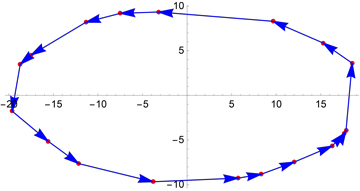Define a greedy tour of a set $S=\{p_1,\ldots,p_n\}$ of $n$ points in $\mathbb{R}^2$ as produced by selecting the $i$-th point $p_i$ to start, and then connecting to the nearest neighbor $p_j$ to $p_i$, then to the nearest neighbor to $p_j$ (excluding $p_i$), and so on, finally closing back to the start $p_i$. So there are $n$ possible greedy tours. Assume general position so there are no ties.
My question is:
When is the shortest greedy tour equal to the TSP? Is there any characterization, or at least sufficient conditions on $S$, such that the shortest greedy tour is the TSP?
For example, below shows the optimal TSP for a $50$-point set, and one of the $50$ greedy tours that fails to achieve the TSP.

Optimal tour $62.5$ compared to $77.4$, greedy starting at $(8.6)$.
Whereas every greedy tour of this set of points on an ellipse is also the TSP tour.
Perhaps the "local feature size" or the "reach of a manifold" can be used to quantify conditions on $S$?

